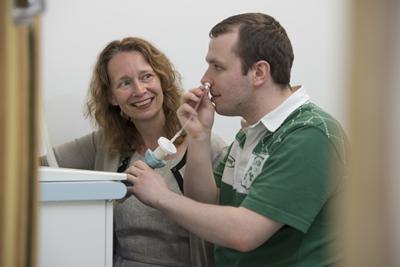Professor Jane Lucas gives Inaugural Lecture

She started as an undergraduate student studying the Batchelor of Medicine at the University of Southampton and now Professor Jane Lucas is finding new ways to treat a rare, genetic, lung disorder called primary ciliary dyskinesia (PCD), that children are born with and will have all their lives. This week Professor Lucas gives her Inaugural Lecture where she will discuss the path she took from Southampton undergrad to being a Professor. She tells us how the medical landscape has changed over the years and why she chose the career she has.
Your inaugural lecture takes place on 20th September 2018, what will it be about?
I’ll be talking about my pathway from undergraduate medical student at University of Southampton to becoming a professor. I’ll reflect on the importance of good mentors, an excellent team and a bit of luck.
What is your current research focus?
I mainly investigate ways to improve the diagnosis and treatment of patients with a rare genetic lung disorder called primary ciliary dyskinesia (PCD)
Why did you decide to focus your career on that particular area of research?
As I finished my training as a paediatric respiratory physician an opportunity arose in Southampton to lead a new NHS national PCD service. I was already interested in PCD, and was a member of the patient organizations advisory board. I jumped at the opportunity. My research naturally aligned with my new clinical focus.
What have been your biggest ‘eureka’ moments in this field?
I’m not sure I would claim any ‘eureka’ moments, but instead a number of small steps to better understand this previously under-researched disorder. Amongst the discoveries I’ve contributed to the identification of four new PCD genes, I’ve developed tools to improve the diagnosis and treatment of PCD, and have furthered our understanding of why people with PCD develop chest infections which are resistant to antibiotic treatment.
How would you describe the rate of progress in your research field that you’ve witnessed?
It’s been a very exiting 10 years; we’ve now got a much better understanding of natural disease progression, and have improved methods for monitoring and treating patients. The most important driver has been international collaborations such as BEATPCD; these networks are essential when investigating a rare disease.
How has the role of women in scientific research changed during the course of your career?
When I was a medical student in Southampton there was already a strong track record of successful women; Dame Barbara Clayton was the first female professor appointed to Southampton medical School, and before my time she had been the first female Dean of a medical school. However, throughout my career the majority of senior academics have been men, and there have been few female role models. There is still an imbalance in senior positions and we need to continue to push the culture change that has started, to ensure that all researchers have the opportunities to reach their potential.
What would you say is your proudest career achievement?
Passing my final exams at medical school which opened the opportunity to my dream of becoming a doctor. I’ve had a number of ‘proud’ moments since, but none has beaten that early success.
What excites you most about the future of your research field?
There is still so much to do; we still don’t have a ‘gold standard’ diagnostic test for PCD, and there is no cure. That’s exciting because every discovery has the potential to improve the health and wellbeing of our patients.